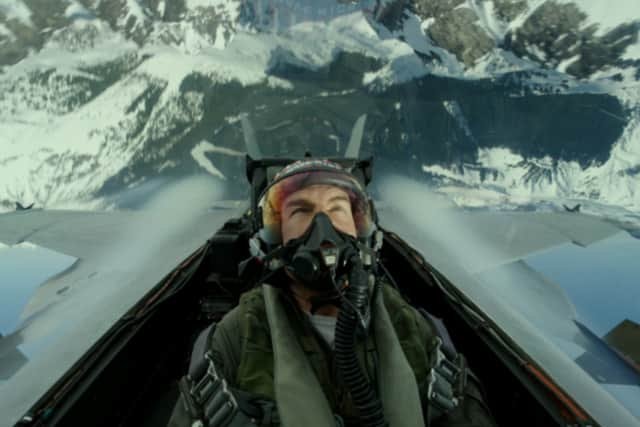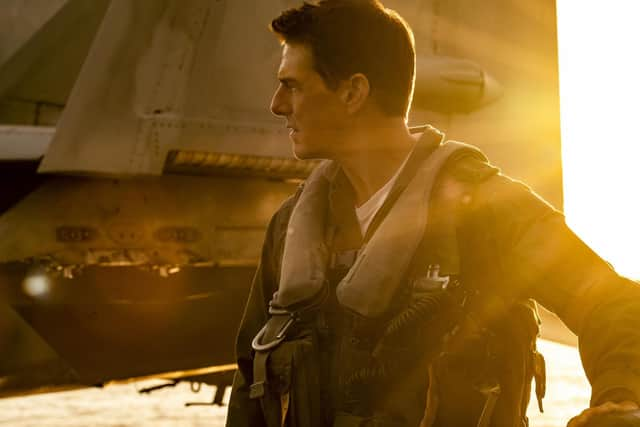Does Tom Cruise fly in Top Gun: Maverick? Pilot license, can he fly fighter jets - how cast shot flying scenes
and live on Freeview channel 276
Top Gun: Maverick is one of the most eagerly anticipated sequels of recent years, with Tom Cruise reprising his role as hotshot military pilot Pete 'Maverick' Mitchell.
Ahead of the film’s release, it’s been clear from trailers that Maverick features some of the most realistically intense aviation scenes ever committed to film. But just how were those effects achieved?
Advertisement
Hide AdAdvertisement
Hide AdFor Cruise, the key to making the sequel was in the filming – and flying – practicalities.
Cruise is known for getting hands on when it comes to stunts and action sequences, opting to shoot everything practically and eschewing stuntmen completely- he recently told The Graham Norton Show he enjoys performing stunts so much he has to be told to stop smiling.
“People had asked for a sequel for decades,” Cruise told the PA News service earlier this month. “And the thing I said to the studio from the beginning was: ‘If I’m ever going to entertain this, we’re shooting everything practically. I’m in that F/A-18, period.”
So were Maverick’s in-flight shots really filmed in the air? Or was computer trickery used?
Here is everything you need to know.
What training did the actors go through?


Advertisement
Hide AdAdvertisement
Hide AdThe cast of the sequel undertook months of extensive flying training, meaning the footage you see of them in F/A-18 aircrafts is indeed real, and not CGI.
That flight training programme was personally developed by Cruise, and saw the actors undertake a unique bootcamp for three months, developing skills in underwater evacuation, aerial aviation and flight itself.
Cruise’s progressive programme also prepared the actors for the enormous dynamic pressures of G-force, which can render pilots unconscious due to a lack of blood supply.
He started his cast out in single-engine planes, before they took to the skies in an Aero L-39 Albatros, a Czech-designed jet trainer widely used by militaries around the world.
Advertisement
Hide AdAdvertisement
Hide AdFinally, the stars advanced to the F-18 Super Hornet after developing a feel for aerobatics, and were launched from an aircraft carrier.
Filming the adrenaline-fueled flying scenes was “intense” for Miles Teller, who plays ‘Rooster’, the son of late pilot (and Maverick’s best friend) ‘Goose’ from the first film.
“We trained for this for a long time, Tom had us in a flight programme for several months before we ever started filming,” he said.
“But it was never something you really ever got, like, super comfortable with, at least for me. It was something that every time I went up, it really tested me and I felt like I wanted to puke pretty much every time.”
How were the flying scenes filmed?


Advertisement
Hide AdAdvertisement
Hide AdNot only did the cast receive flight training, they also had to learn to operate the special IMAX camera rigs used for shooting the in-cockpit scenes, as the space was too small for director Joseph Kosinski to join them in the air.
“I never got in an F-18,” says Kosinski when asked if he did any flying. “The closest I came was Tom [Cruise] would fly me back and forth to work [in a helicopter] sometimes.”
The cast also needed to be trained in lighting, cinematography and editing, because they had to direct themselves while in the aircraft.
The first Top Gun changed the way aerial sequences were shot, and the sequel, inspired by GoPro films from Navy pilots, sought to do the same.
Advertisement
Hide AdAdvertisement
Hide AdBut while GoPro footage is all well and good for a quick and shareable viral video, it can’t compete with the crisp images captured by Hollywood’s 6K, high-resolution cameras.
So special rigs were developed, with the crew working with Navy personnel for over a year to deploy cameras inside the cockpit: four cameras facing the actors and two facing forward, as well as cameras positioned all across the exterior of the aircraft.
“For years, people had said, ‘Can’t you shoot [the movie] with CGI?’ And I always said, ‘No. That’s not the experience. This movie is like trying to hit a bullet with a bullet. I’m not playing.’”
Were the actors actually at the controls?
While Cruise really is sat in the cockpit of an aircraft during Top Gun: Maverick, he’s not always actually at the plane’s controls.
Advertisement
Hide AdAdvertisement
Hide AdThe 59-year-old actor, who is a licensed pilot, did fly a P-51 propeller-driven fighter plane and a few helicopters, but the Navy denied him permission to fly an F-18 fighter jet.
The F-18 Super Hornet boasts a price tag in excess of $70 million (£56 million), so it's easy to see why the Navy may not have been keen on a Hollywood star taking to the controls - that’s roughly half of the film’s $152 million (£122 million) budget.
Plus, if a relatively inexperienced pilot such as Cruise were to lose control of, it could put civilians and military troops on the ground in danger, another reason for keeping him out of the F-18’s cockpit.
Then there’s the issue of insurance, a factor that often keeps performers from performing their own stunts...
Advertisement
Hide AdAdvertisement
Hide AdTop Gun: Maverick does depict real F-18s, but external shots of those planes were produced with the help of Navy pilots in control.
If stunt-happy Cruise wasn’t actually piloting the jets in interior shots, you can bet his supporting cast weren’t either: their scenes would similarly have been filmed in the air for real, but with a Navy pilot actually at the controls.
Thankfully, the action sequences should remain convincing to even the most experienced eye with the help of expert editing.
Comment Guidelines
National World encourages reader discussion on our stories. User feedback, insights and back-and-forth exchanges add a rich layer of context to reporting. Please review our Community Guidelines before commenting.
